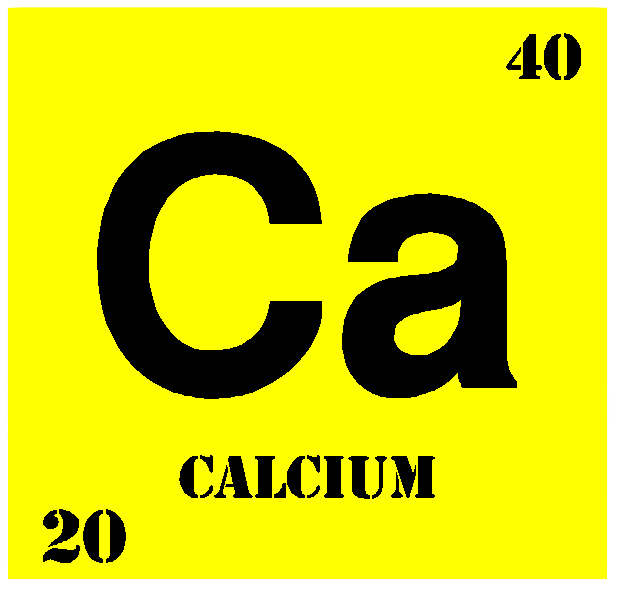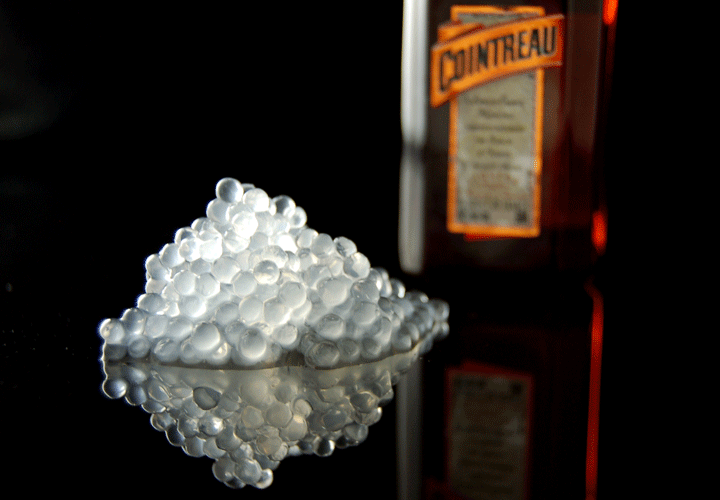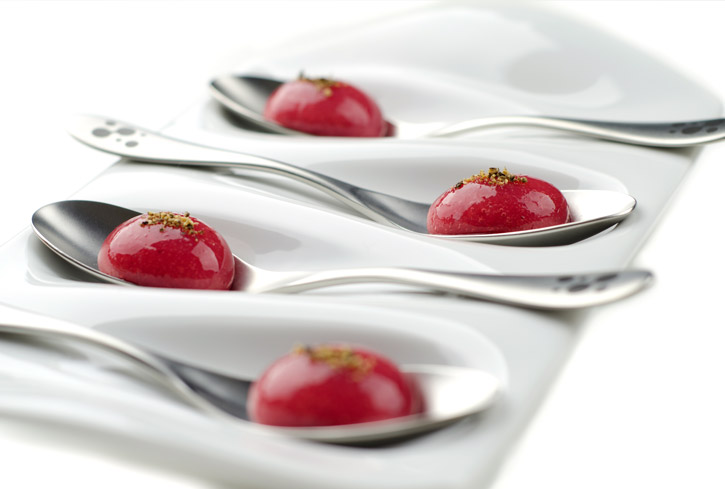Calcium Chloride, Calcium Lactate, Calcium Lactate Gluconate
Calcium salts such as Calcium Chloride, Calcium lactate, Calcium lactate gluconate are used in modernist cuisine to produce gels in combination with hydrocolloids that require ions such as calcium to gel. Sodium Alginate, Low Acyl Gellan, Low-methoxyl Pectin and Iota Carrageenan only gel in the presence of ions such as calcium. One of the most famous application of these ingredients pioneered by Chef Ferran Adria is Spherification, a technique to make spheres by encapsulating a liquid with a gel membrane produced by the reaction of sodium alginate with calcium.
Calcium Salts Origin
 Calcium is the chemical element with symbol Ca and atomic number 20. Calcium is a soft gray alkaline earth metal, and is the fifth-most-abundant element by mass in the Earth's crust. Calcium is also the fifth-most-abundant dissolved ion in seawater by both molarity and mass, after sodium, chloride, magnesium, and sulfate.
Calcium is the chemical element with symbol Ca and atomic number 20. Calcium is a soft gray alkaline earth metal, and is the fifth-most-abundant element by mass in the Earth's crust. Calcium is also the fifth-most-abundant dissolved ion in seawater by both molarity and mass, after sodium, chloride, magnesium, and sulfate.
Calcium is essential for living organisms, in particular in cell physiology, where movement of the calcium ion Ca2+ into and out of the cytoplasm functions as a signal for many cellular processes. As a major material used in mineralization of bone, teeth and shells, calcium is the most abundant metal by mass in many animals.
Salts are ionic compounds that can result from the neutralization reaction of an acid and a base. They are composed of related numbers of cations (positively charged ions) and anions (negative ions) so that the product is electrically neutral (without a net charge). Calcium salts produced calcium ions when dissolved in water and these ions are what we need to produce gels with Sodium Alginate, Low Acyl Gellan, Low-methoxyl Pectin and Iota Carrageenan.
Calcium chloride, CaCl2, is a salt of calcium and chlorine. It behaves as a typical ionic halide, and is solid at room temperature. Common applications include brine for refrigeration plants, ice and dust control on roads, and desiccation. Because of its hygroscopic nature, anhydrous calcium chloride must be kept in tightly sealed, air-tight containers. Calcium chloride can be produced directly from limestone, but large amounts are also produced as a by product of the Solvay process. Calcium chloride tastes salty so in molecular gastronomy it is used mostly to make the calcium bath for Basic Spherification since it is not consumed and therefore flavor doesn't matter. For Reverse Spherification and other gels, calcium lactate or calcium lactate gluconate are preferred to obtain a better taste.
Calcium lactate is a black or white crystalline salt made by the action of lactic acid on calcium carbonate. It is used in foods (as an ingredient in baking powder) and given medicinally. Cheese crystals usually consist of calcium lactate, especially those found on the outside, on younger cheese, and on Cheddar cheese. In medicine, calcium lactate is most commonly used as an antacid and also to treat calcium deficiencies. Calcium lactate is added to sugar-free foods to prevent tooth decay. It is also added to fresh-cut fruits such as cantaloupes to keep them firm and extend their shelf life, without the bitter taste caused by calcium chloride, which can also be used for this purpose.
Calcium gluconate is a mineral supplement. It is manufactured by the neutralization of gluconic acid with lime or calcium carbonate. Its calcium content is relatively low.
Calcium lactate gluconate is a mixture of calcium lactate and calcium gluconate and is the preferred calcium salt by Chef Ferran Adria due to its neutral flavor. In food and beverages, the outstanding characteristics of Calcium Lactate Gluconate combining high solubility and neutral taste, make it ideal for Calcium-fortification in a wide range of premium products.
Calcium Salts Function
In modernist cuisine, calcium salts are used to produce gels in combination with hydrocolloids that require ions such as calcium to gel. Sodium Alginate, Low Acyl Gellan, Low-methoxyl Pectin and Iota Carrageenan only gel in the presence of ions such as calcium. One of the most famous applications of these ingredients pioneered by Chef Ferran Adria is Spherification, a technique to make spheres by encapsulating a liquid with a gel membrane produced by the reaction of sodium alginate with calcium.
In order to gel, these hydrocolloids need a concentration of calcium ions of about 0.04%. But these ions also difficult the proper hydration of the hydrocolloids which is necessary to form a gel. So it is very common to hydrate in a liquid without calcium ions and then add calcium to the solution to form a gel. For these reasons, calcium salts are very handy when working with Sodium Alginate, Low Acyl Gellan, Low-methoxyl Pectin and Iota Carrageenan.
Calcium Salts Applications
Calcium salts can be used to produce gels with Sodium Alginate, Low Acyl Gellan, Low-methoxyl Pectin and Iota Carrageenan. In molecular gastronomy, Calcium Chloride is frequently used in the bath of Basic Spherification to make caviar-like spheres with liquid inside such as the Caviar of Cointreau shown below. Even though the calcium chloride is very salty, in this case it doesn't matter because the calcium bath is never consumed and the spheres can be rinsed to remove any excess calcium on the surface.
However, in other applications in which the calcium is mixed with the ingredient to be consumed, Calcium Lactate and Calcium Lactate Gluconate are preferred for their neutral taste. The latter is the best option and frequently used to prepare the main ingredient in Reverse Spherification such as in Strawberry Spheres with Ground Pepper.
View recipes with Calcium Chloride
View recipes with Calcium Lactate Gluconate
How to use Calcium Salts
Concentration Range: different calcium salts contain different amounts of calcium ions and therefore the amount you use will be different too. In order to gel, Sodium Alginate, Low Acyl Gellan, Low-methoxyl Pectin and Iota Carrageenan need a minimum concentration of calcium ions of about 0.04%. In spherification it is common to use a higher calcium concentration of 0.18% to speed up the gelification process and obtain a stronger gel.
| Calcium Salt | Calcium Content | Qty to Make 0.18% Ca solution |
| Calcium Chloride | 36.1% | 0.5% |
| Calcium Lactate | 18.4% | 1% |
| Calcium Lactate Gluconate | 9.3% | 2% |
For example, if a recipe calls for 1% of calcium chloride, you can replace it with 2% of calcium lactate or 4% of calcium lactate gluconate. Basically the ratio between quantities required of each calcium salt is 1:2:4.
Do not add the calcium salt until the hydrocolloid has been hydrated in a liquid with no calcium ions such as distilled water or milk. If the liquid to be used has natural calcium in it, you may have to use a sequestrant such as Sodium Citrate to bind the calcium ions and enable hydration. After the hydrocolloid has been hydrated, you can add the calcium salt.







